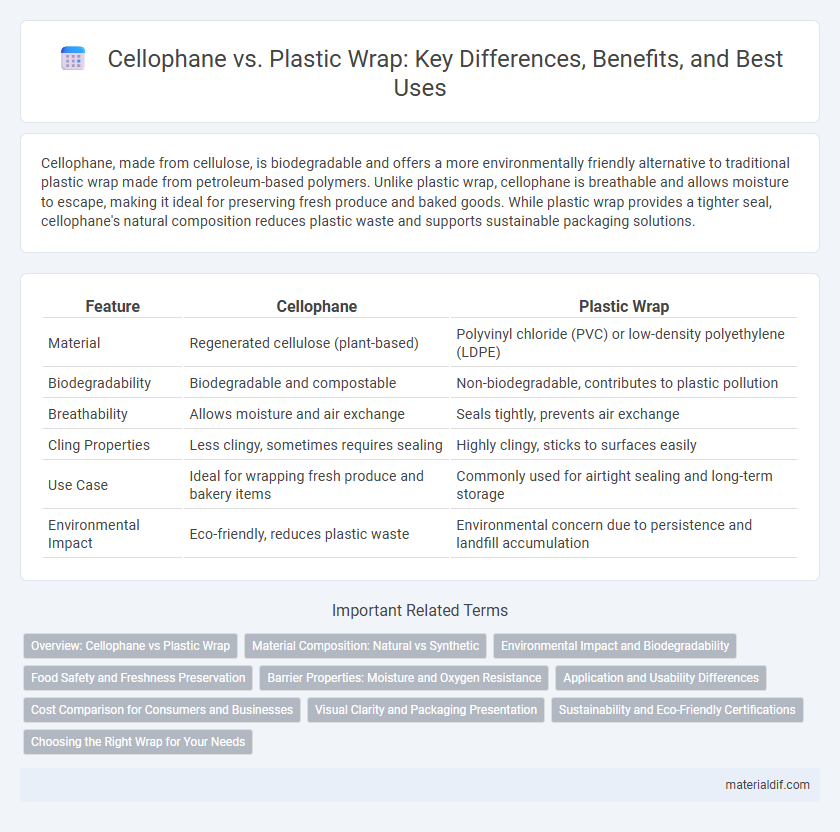Cellophane, made from cellulose, is biodegradable and offers a more environmentally friendly alternative to traditional plastic wrap made from petroleum-based polymers. Unlike plastic wrap, cellophane is breathable and allows moisture to escape, making it ideal for preserving fresh produce and baked goods. While plastic wrap provides a tighter seal, cellophane's natural composition reduces plastic waste and supports sustainable packaging solutions.
Table of Comparison
| Feature | Cellophane | Plastic Wrap |
|---|---|---|
| Material | Regenerated cellulose (plant-based) | Polyvinyl chloride (PVC) or low-density polyethylene (LDPE) |
| Biodegradability | Biodegradable and compostable | Non-biodegradable, contributes to plastic pollution |
| Breathability | Allows moisture and air exchange | Seals tightly, prevents air exchange |
| Cling Properties | Less clingy, sometimes requires sealing | Highly clingy, sticks to surfaces easily |
| Use Case | Ideal for wrapping fresh produce and bakery items | Commonly used for airtight sealing and long-term storage |
| Environmental Impact | Eco-friendly, reduces plastic waste | Environmental concern due to persistence and landfill accumulation |
Overview: Cellophane vs Plastic Wrap
Cellophane is a biodegradable, cellulose-based film derived from wood pulp, offering a sustainable alternative to traditional plastic wrap made from polyethylene or PVC. Plastic wrap provides superior stretchiness and cling, making it ideal for sealing containers and preserving food, whereas cellophane is more rigid and breathable, often used for packaging rather than airtight sealing. The environmental impact of cellophane is significantly lower, decomposing naturally within weeks, in contrast to plastic wrap which can take hundreds of years to break down in landfills.
Material Composition: Natural vs Synthetic
Cellophane is derived from cellulose, a natural polymer obtained primarily from wood pulp or cotton fibers, making it biodegradable and eco-friendly. In contrast, plastic wrap is typically made from synthetic polymers such as polyethylene or polyvinyl chloride, which are petroleum-based and non-biodegradable. This fundamental difference in material composition impacts environmental sustainability, with cellophane offering a natural alternative to traditional plastic wraps.
Environmental Impact and Biodegradability
Cellophane is derived from cellulose, making it biodegradable and compostable within weeks, unlike conventional plastic wrap, which is petroleum-based and can persist in the environment for hundreds of years. The production of cellophane generates fewer greenhouse gas emissions and is less reliant on fossil fuels compared to plastic wrap manufacturing. Disposal of cellophane reduces landfill burden and marine pollution, while plastic wrap contributes significantly to microplastic contamination in oceans.
Food Safety and Freshness Preservation
Cellophane, a biodegradable film made from cellulose, offers superior breathability compared to conventional plastic wrap, reducing moisture buildup and preventing food spoilage. It allows for better gas exchange, which helps preserve the freshness of fruits and vegetables by minimizing condensation and mold growth. In contrast, plastic wrap tends to trap moisture and can promote bacterial growth, potentially compromising food safety over time.
Barrier Properties: Moisture and Oxygen Resistance
Cellophane offers superior oxygen resistance due to its dense cellulose structure, reducing oxygen permeability and effectively preserving food freshness. Plastic wrap typically provides better moisture barrier properties because it is made from polyethylene, which is less permeable to water vapor than cellophane. The choice between cellophane and plastic wrap depends on the specific need for either moisture control or oxygen exclusion in packaging applications.
Application and Usability Differences
Cellophane offers superior breathability compared to traditional plastic wrap, making it ideal for wrapping fresh produce and baked goods to maintain freshness without trapping moisture. Plastic wrap excels in sealing containers and creating airtight barriers, which is beneficial for long-term storage or preventing spills. The biodegradable nature of cellophane aligns with sustainable packaging needs, while plastic wrap remains more versatile for varied household applications due to its elasticity and adhesive properties.
Cost Comparison for Consumers and Businesses
Cellophane typically costs more than plastic wrap due to its natural cellulose base and biodegradable properties, making it a premium option for eco-conscious consumers and businesses. Plastic wrap, made from petroleum-based polymers, offers a lower price point and widespread availability, appealing to cost-sensitive households and commercial users. For businesses, choosing cellophane may result in higher upfront expenses but aligns with sustainability goals, while plastic wrap provides a budget-friendly solution with less environmental consideration.
Visual Clarity and Packaging Presentation
Cellophane offers superior visual clarity compared to plastic wrap, providing a crystal-clear, glossy finish that enhances product presentation on shelves. The transparent nature of cellophane allows consumers to view the product without distortion, making it ideal for premium packaging and gift wrapping. Unlike plastic wrap, cellophane maintains its clarity over time and resists clouding, ensuring consistent visual appeal.
Sustainability and Eco-Friendly Certifications
Cellophane is a biodegradable and compostable film made from cellulose, derived from renewable sources like wood pulp, making it more sustainable than plastic wrap, which is typically petroleum-based and non-biodegradable. Eco-friendly certifications for cellophane include FDA approval for food safety and compostability certifications such as ASTM D6400 and EN 13432, ensuring its environmental compliance and reduced landfill impact. Plastic wrap rarely carries such certifications and often contributes to long-term plastic pollution, hindering sustainability efforts.
Choosing the Right Wrap for Your Needs
Cellophane offers a biodegradable and breathable alternative to plastic wrap, making it ideal for storing fresh produce and preventing moisture buildup. Plastic wrap provides superior flexibility and airtight sealing, which is better suited for wrapping irregularly shaped items and preserving leftovers for longer periods. Selecting the right wrap depends on balancing environmental impact with storage requirements, where cellophane suits eco-conscious consumers and plastic wrap excels in versatile food preservation.
Cellophane vs Plastic Wrap Infographic

 materialdif.com
materialdif.com